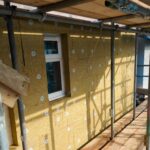In Retrofit by Robert Wheeler / 6 March 2024 / 0 comments

Retrofit works have gained significant attention in recent years as a sustainable solution for improving existing buildings, infrastructure, and systems. Retrofitting refers to the process of making modifications or upgrades to enhance the energy efficiency, functionality, and performance of an already constructed structure.
In this blog post, we will delve into the concept of retrofit works, exploring its importance, benefits, common types of projects, the step-by-step process involved, challenges faced, and notable case studies. Additionally, we will discuss future trends and innovations in retrofitting, shedding light on the promising advancements that lie ahead. Whether you are a homeowner, building professional, or simply curious about the world of retrofitting, this article will provide valuable insights into this transformative practice.
Introduction to Retrofit Works
What is Retrofitting?
Retrofitting is like giving your home or building a makeover to make it more energy-efficient, comfortable, and environmentally friendly. It involves making improvements or upgrades to existing structures, systems, or components.
Importance of Retrofit Works
Retrofit works are crucial in today’s world where sustainability and energy conservation have become paramount. By retrofitting our homes, buildings, and infrastructure, we can reduce energy consumption, lower carbon emissions, and save money on utility bills. Plus, it’s a win-win situation for both the planet and our wallets!
Understanding the Concept of Retrofitting
Definition and Scope of Retrofitting
Retrofitting is not just about slapping on a fresh coat of paint or updating the décor. It involves making substantial changes to enhance the overall performance and efficiency of a structure. This can include improving insulation, upgrading HVAC systems, replacing windows, and implementing renewable energy solutions.
Key Objectives of Retrofit Projects
The primary goals of retrofit projects are to reduce energy consumption and greenhouse gas emissions, enhance occupant comfort, and improve the durability and longevity of the structure. These projects aim to bring older buildings up to modern standards while taking advantage of innovative technologies and sustainable practices.
Benefits of Retrofit Works
Energy Efficiency and Cost Savings
One of the significant benefits of retrofit works is the potential for significant energy savings. By improving insulation, sealing air leaks, and upgrading to energy-efficient appliances, we can reduce our reliance on fossil fuels and slash those monthly energy bills. Retrofitting may require an upfront investment, but the long-term savings are worth it.
Environmental Impact Reduction
Retrofitting plays a vital role in reducing our carbon footprint and mitigating the environmental impact of buildings. Through energy conservation measures, renewable energy integration, and sustainable construction practices, retrofit projects contribute to a greener and more sustainable future.
Improved Comfort and Indoor Air Quality
Retrofit works can significantly enhance the comfort of a building by addressing issues such as temperature fluctuations, drafts, and poor ventilation. By improving insulation, upgrading heating and cooling systems, and implementing proper air filtration, occupants can enjoy a more comfortable living or working environment with better indoor air quality.
Common Types of Retrofit Projects
Residential Retrofitting
Residential retrofitting focuses on improving older homes to make them more energy-efficient. This may involve insulation upgrades, window replacements, solar panel installations, and the integration of smart home technologies.
Commercial and Industrial Retrofitting
Commercial and industrial buildings often have higher energy demands. Retrofitting these structures can include HVAC system updates, lighting upgrades, energy management systems, and the utilization of renewable energy sources to reduce operational costs and environmental impact.
Infrastructure Retrofitting
Infrastructure retrofitting involves making improvements to public facilities and utilities such as bridges, roads, water systems, and transportation networks. These projects aim to enhance functionality, safety, and sustainability while addressing aging infrastructure and adapting to changing needs.
Remember, retrofitting isn’t just about saving money or reducing our carbon footprint—it’s about creating a more comfortable and sustainable future for all. So, let’s embrace the power of retrofit works and make a positive impact, one upgrade at a time!
Steps Involved in Retrofitting Process
Initial Energy Audit and Assessment
Before embarking on a retrofit project, the first step is to conduct an initial energy audit and assessment. This involves analysing the current energy usage and identifying areas for improvement. Energy experts swoop in like energy detectives, examining your building from top to bottom, looking for any energy-wasting culprits and calculating potential savings.
Design and Planning
Once the energy audit is complete, it’s time to bring in the design and planning team. They’ll put their creative hats on (or hard hats, depending on the situation) and come up with the best solutions to increase energy efficiency. From choosing the right materials to determining the most effective layout, they’ll make sure your retrofit is not just functional but also fabulous.
Implementation and Execution
Now comes the exciting part – turning those plans into reality! This phase involves hiring skilled contractors and specialists to carry out the retrofit works. They’ll handle everything from installing energy-efficient lighting to upgrading insulation and HVAC systems. It’s like giving your building a makeover, but instead of new clothes, it gets new energy-saving features.
Monitoring and Evaluation
Once the retrofit works are complete, it’s important to keep an eye on how well your building is performing. Monitoring and evaluation help determine if the retrofit measures are achieving the desired energy savings. Think of it as tracking the progress of your building’s energy journey. This way, you can make any necessary adjustments or improvements to ensure optimal efficiency.
Challenges and Considerations in Retrofit Works
Financial and Funding Challenges
One of the biggest challenges in retrofit works is funding. Retrofit projects can require a significant investment, and finding the financial resources can be like searching for a needle in a haystack. However, various funding options and incentives, such as government grants or energy performance contracts, can make the process more feasible and financially rewarding.
Technical and Engineering Constraints
Retrofitting an existing building can present technical and engineering challenges. Every building has its quirks and limitations, making it important to find innovative solutions that work within those constraints. It’s like solving a puzzle, where the pieces are your building’s unique features and the goal is maximum energy efficiency.
Stakeholder Engagement and Collaboration
Getting everyone on board for a retrofit project can sometimes feel like herding cats. Engaging stakeholders, such as building owners, tenants, and occupants, is crucial for the success of any retrofit works. It requires effective communication, collaboration, and maybe even a touch of persuasion. But once everyone realizes the benefits, it becomes a team effort towards a greener and more efficient future.
Case Studies and Success Stories of Retrofit Projects
From transforming an old, energy-guzzling office building into a sustainable powerhouse to revamping an outdated residential complex into an eco-friendly haven, there are numerous inspiring case studies and success stories of retrofit projects. These stories showcase the tangible benefits, both for the environment and the building owners’ wallets.
Future Trends and Innovations in Retrofitting
The world of retrofitting is constantly evolving, and there are exciting trends and innovations on the horizon. From smart building technologies and advanced energy management systems to renewable energy integration and even retrofitting historic buildings, the future of retrofitting looks bright (and energy-efficient). Stay tuned for even more ways to give your buildings a modern, sustainable upgrade
Conclusion
In conclusion, retrofit works offer a compelling solution for optimizing existing structures and systems, leading to improved energy efficiency, reduced environmental impact, and enhanced comfort. With the constant advancements in technology and growing awareness of sustainability, retrofitting is expected to play a crucial role in shaping the future of construction and infrastructure. By embracing retrofit projects, we can contribute to a greener and more efficient built environment. So, whether it’s retrofitting your own home or advocating for retrofit initiatives on a larger scale, let us continue to explore and embrace the potential of retrofit works for a brighter and more sustainable future.
FAQs: Retrofit Works
Retrofitting involves making modifications or upgrades to existing structures or systems to improve their performance and energy efficiency. On the other hand, new construction refers to the process of building entirely new structures from scratch. Retrofitting allows for the improvement of already existing buildings and infrastructure, minimizing the need for demolition and reducing waste.
The duration of a retrofit project can vary depending on the scale and complexity of the project. Smaller residential retrofit projects can typically be completed within a few weeks to a couple of months, while larger commercial or infrastructure retrofit projects may take several months or even years to complete. Factors such as design, planning, availability of resources, and coordination with contractors can influence the timeline of a retrofit project.
Yes, there are often financial incentives and assistance programs available to support retrofit projects. These can include grants, rebates, tax credits, and low-interest loans provided by governments, utilities, and other organizations. It is advisable to research and explore the available incentives and assistance programs specific to your location and project type to maximize the financial benefits of your retrofit works.
Yes, retrofit works can be applied to various types of buildings and infrastructure, including residential, commercial, industrial, and public facilities. Retrofitting offers the opportunity to enhance the energy efficiency, functionality, and sustainability of both old and relatively newer structures, making it a versatile practice applicable to a wide range of architectural styles and building types.
Ready to discuss your regeneration project and how NXTGEN Futures Ltd can elevate it with expert retrofit? Contact us today!
Latest Retrofit Posts
- What a retrofit-first approach offers the UKRetrofitting is like giving your home a makeover to make it more energy-efficient, comfortable, and healthy. The retrofit-first approach prioritizes upgrading existing buildings over new construction to tackle climate change and improve living conditions. Definition of Retrofitting Retrofitting involves making… Read more: What a retrofit-first approach offers the UK
- What is internal wall insulation?Internal wall insulation is a crucial component of creating a comfortable and energy-efficient living space. By insulating the walls within a building, homeowners can experience benefits such as improved thermal performance, reduced energy bills, and enhanced acoustic comfort. Understanding the… Read more: What is internal wall insulation?
- What is a retrofit assessor?Retrofit assessors play a crucial role in the sustainability and energy efficiency of buildings by evaluating and identifying opportunities for improvement. This blog post aims to provide an in-depth understanding of the responsibilities, qualifications, and benefits associated with being a… Read more: What is a retrofit assessor?
- What is a retrofit assessment in the UK?Retrofit assessments play a crucial role in the sustainable development of buildings in the UK, helping to improve energy efficiency, reduce carbon emissions, and enhance overall building performance. By evaluating existing structures and identifying opportunities for upgrades and enhancements, retrofit… Read more: What is a retrofit assessment in the UK?
- Retrofit and Energy Efficiency in Historic BuildingsHistoric buildings are not only architectural treasures but also valuable cultural assets that contribute to our sense of history and identity. However, many of these buildings often suffer from poor energy efficiency, leading to excessive energy consumption and high operating… Read more: Retrofit and Energy Efficiency in Historic Buildings
- What is retrofitting in construction?Retrofitting in construction is a crucial process that involves upgrading existing buildings or structures to meet modern standards of safety, energy efficiency, and functionality. This blog post explores the concept of retrofitting, its importance, various techniques used in the industry,… Read more: What is retrofitting in construction?
- CASE STUDY: Curtis WayDelivering a Holistic Retrofit Solution with EWI & Solar Energy Project Overview NXTGEN Futures Ltd. successfully completed a large-scale retrofit project on Curtis Way, Berkhamsted, England, UK. This case study showcases our expertise in External Wall Insulation (EWI), retrofit coordination,… Read more: CASE STUDY: Curtis Way
- What happens to a building during retrofitting?Building retrofitting is a vital process that involves making significant modifications and improvements to existing structures to enhance their efficiency, functionality, and sustainability. In this blog post, we will delve into the intricate workings of building retrofitting, exploring the various… Read more: What happens to a building during retrofitting?
- UK Government Retrofit Scheme: Making Energy Efficiency Cool AgainIntroduction to the UK Government Retrofit Scheme Background of the Retrofit Scheme Picture this: you’re sitting at home, snuggled up in your favourite blanket, enjoying a cup of tea, when suddenly you feel a draft. Not cool, right? Well, that’s… Read more: UK Government Retrofit Scheme: Making Energy Efficiency Cool Again
- What are Retrofit Trickle Vents?Improving indoor air quality and enhancing energy efficiency are key priorities for many homeowners. In this article, we will explore the concept of retrofit trickle vents and their role in achieving these goals. Trickle vents are small, adjustable openings integrated… Read more: What are Retrofit Trickle Vents?
- Retrofit Underfloor HeatingRetrofit underfloor heating has gained significant popularity as a cost-effective and efficient solution for enhancing the comfort and energy efficiency of existing buildings. Unlike traditional radiator systems, underfloor heating distributes warmth evenly across the floor, providing a comfortable and cozy… Read more: Retrofit Underfloor Heating
- Retrofit LondonRetrofitting has emerged as a crucial solution in transforming the landscape of cities, and London is no exception. As a global hub of culture, commerce, and innovation, London faces the pressing challenge of reducing its carbon footprint while ensuring sustainable… Read more: Retrofit London












